Nursing Assignment: Bio-psychosocial Factors and Dementia Care
VerifiedAdded on 2022/11/24
|11
|2965
|228
Essay
AI Summary
This nursing assignment delves into the multifaceted effects of dementia, analyzing its impact on individuals through a bio-psychosocial framework. The essay explores biological factors like neurodegeneration, psychological aspects such as depression and anxiety, and social elements including age and support systems. It examines how these factors intertwine to affect a patient's overall health and well-being, using the case of Mr. Brown to illustrate these concepts. The discussion covers the bio-psychosocial model, its application in dementia care, and the significance of considering individual experiences and social identities. The assignment highlights the importance of person-centered care, the challenges in diagnosis, and the need for comprehensive treatment approaches that address the biological, psychological, and social dimensions of the disease, ultimately emphasizing the importance of a holistic understanding of dementia to improve patient outcomes and quality of life.
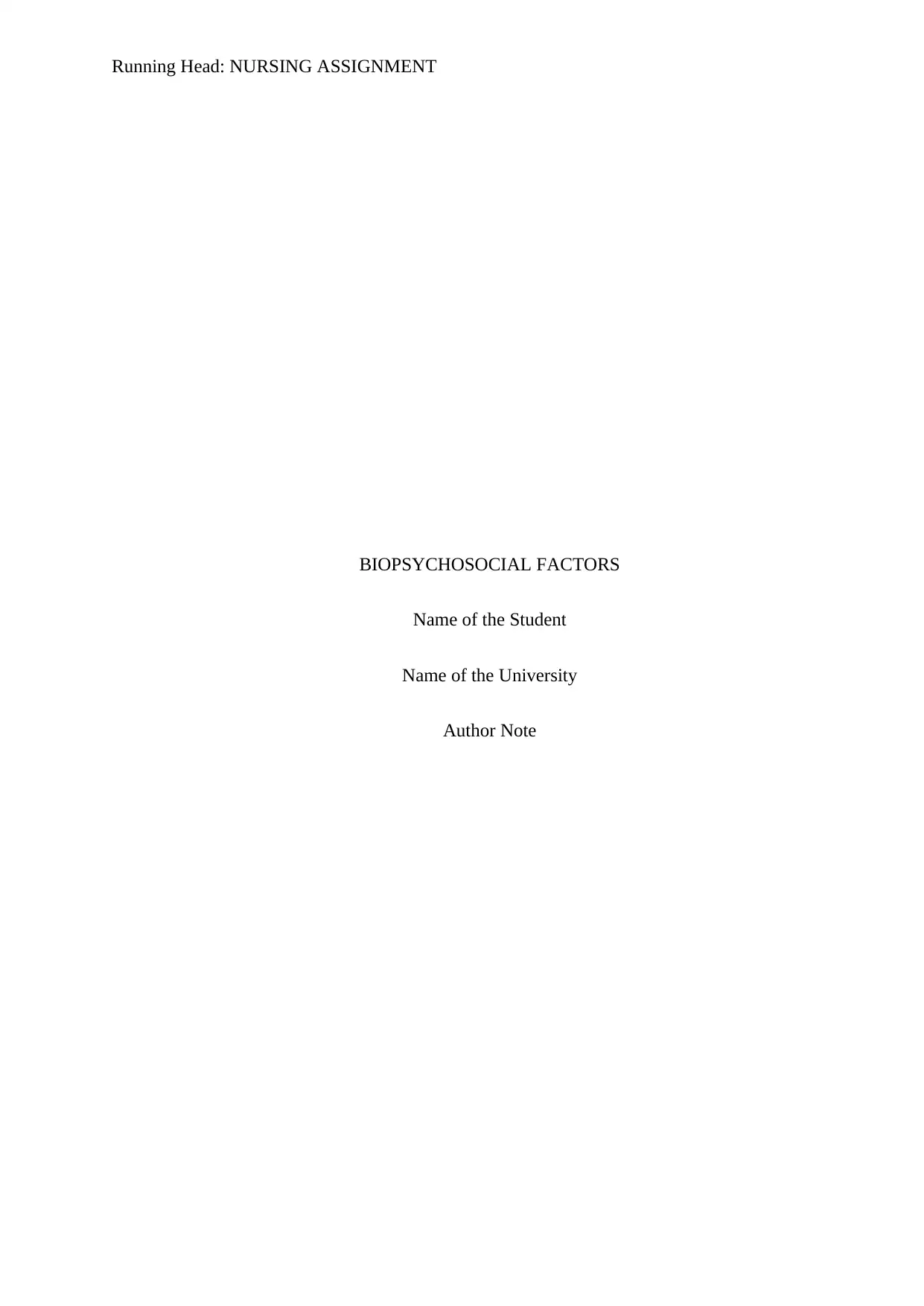
Running Head: NURSING ASSIGNMENT
BIOPSYCHOSOCIAL FACTORS
Name of the Student
Name of the University
Author Note
BIOPSYCHOSOCIAL FACTORS
Name of the Student
Name of the University
Author Note
Paraphrase This Document
Need a fresh take? Get an instant paraphrase of this document with our AI Paraphraser
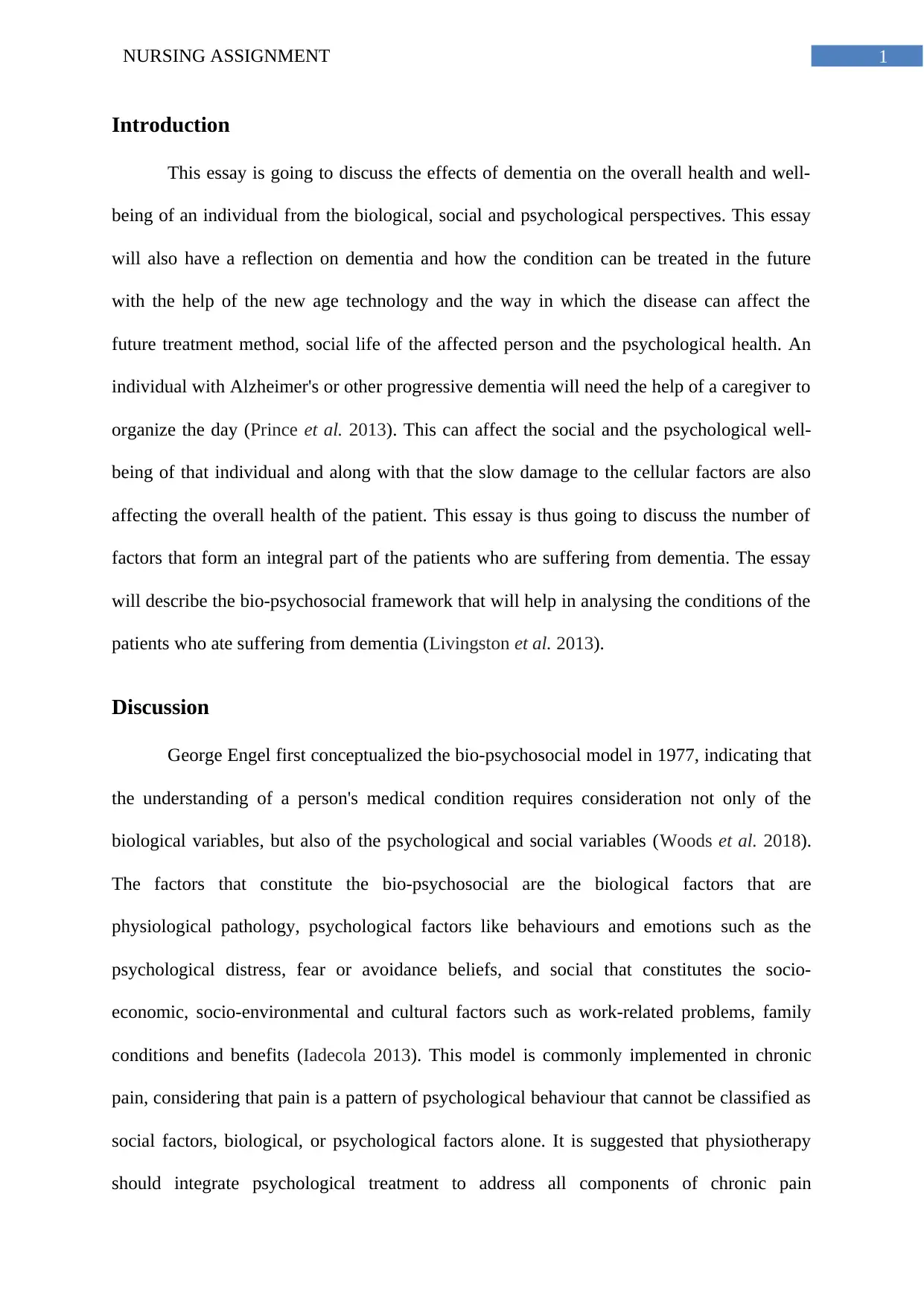
1NURSING ASSIGNMENT
Introduction
This essay is going to discuss the effects of dementia on the overall health and well-
being of an individual from the biological, social and psychological perspectives. This essay
will also have a reflection on dementia and how the condition can be treated in the future
with the help of the new age technology and the way in which the disease can affect the
future treatment method, social life of the affected person and the psychological health. An
individual with Alzheimer's or other progressive dementia will need the help of a caregiver to
organize the day (Prince et al. 2013). This can affect the social and the psychological well-
being of that individual and along with that the slow damage to the cellular factors are also
affecting the overall health of the patient. This essay is thus going to discuss the number of
factors that form an integral part of the patients who are suffering from dementia. The essay
will describe the bio-psychosocial framework that will help in analysing the conditions of the
patients who ate suffering from dementia (Livingston et al. 2013).
Discussion
George Engel first conceptualized the bio-psychosocial model in 1977, indicating that
the understanding of a person's medical condition requires consideration not only of the
biological variables, but also of the psychological and social variables (Woods et al. 2018).
The factors that constitute the bio-psychosocial are the biological factors that are
physiological pathology, psychological factors like behaviours and emotions such as the
psychological distress, fear or avoidance beliefs, and social that constitutes the socio-
economic, socio-environmental and cultural factors such as work-related problems, family
conditions and benefits (Iadecola 2013). This model is commonly implemented in chronic
pain, considering that pain is a pattern of psychological behaviour that cannot be classified as
social factors, biological, or psychological factors alone. It is suggested that physiotherapy
should integrate psychological treatment to address all components of chronic pain
Introduction
This essay is going to discuss the effects of dementia on the overall health and well-
being of an individual from the biological, social and psychological perspectives. This essay
will also have a reflection on dementia and how the condition can be treated in the future
with the help of the new age technology and the way in which the disease can affect the
future treatment method, social life of the affected person and the psychological health. An
individual with Alzheimer's or other progressive dementia will need the help of a caregiver to
organize the day (Prince et al. 2013). This can affect the social and the psychological well-
being of that individual and along with that the slow damage to the cellular factors are also
affecting the overall health of the patient. This essay is thus going to discuss the number of
factors that form an integral part of the patients who are suffering from dementia. The essay
will describe the bio-psychosocial framework that will help in analysing the conditions of the
patients who ate suffering from dementia (Livingston et al. 2013).
Discussion
George Engel first conceptualized the bio-psychosocial model in 1977, indicating that
the understanding of a person's medical condition requires consideration not only of the
biological variables, but also of the psychological and social variables (Woods et al. 2018).
The factors that constitute the bio-psychosocial are the biological factors that are
physiological pathology, psychological factors like behaviours and emotions such as the
psychological distress, fear or avoidance beliefs, and social that constitutes the socio-
economic, socio-environmental and cultural factors such as work-related problems, family
conditions and benefits (Iadecola 2013). This model is commonly implemented in chronic
pain, considering that pain is a pattern of psychological behaviour that cannot be classified as
social factors, biological, or psychological factors alone. It is suggested that physiotherapy
should integrate psychological treatment to address all components of chronic pain
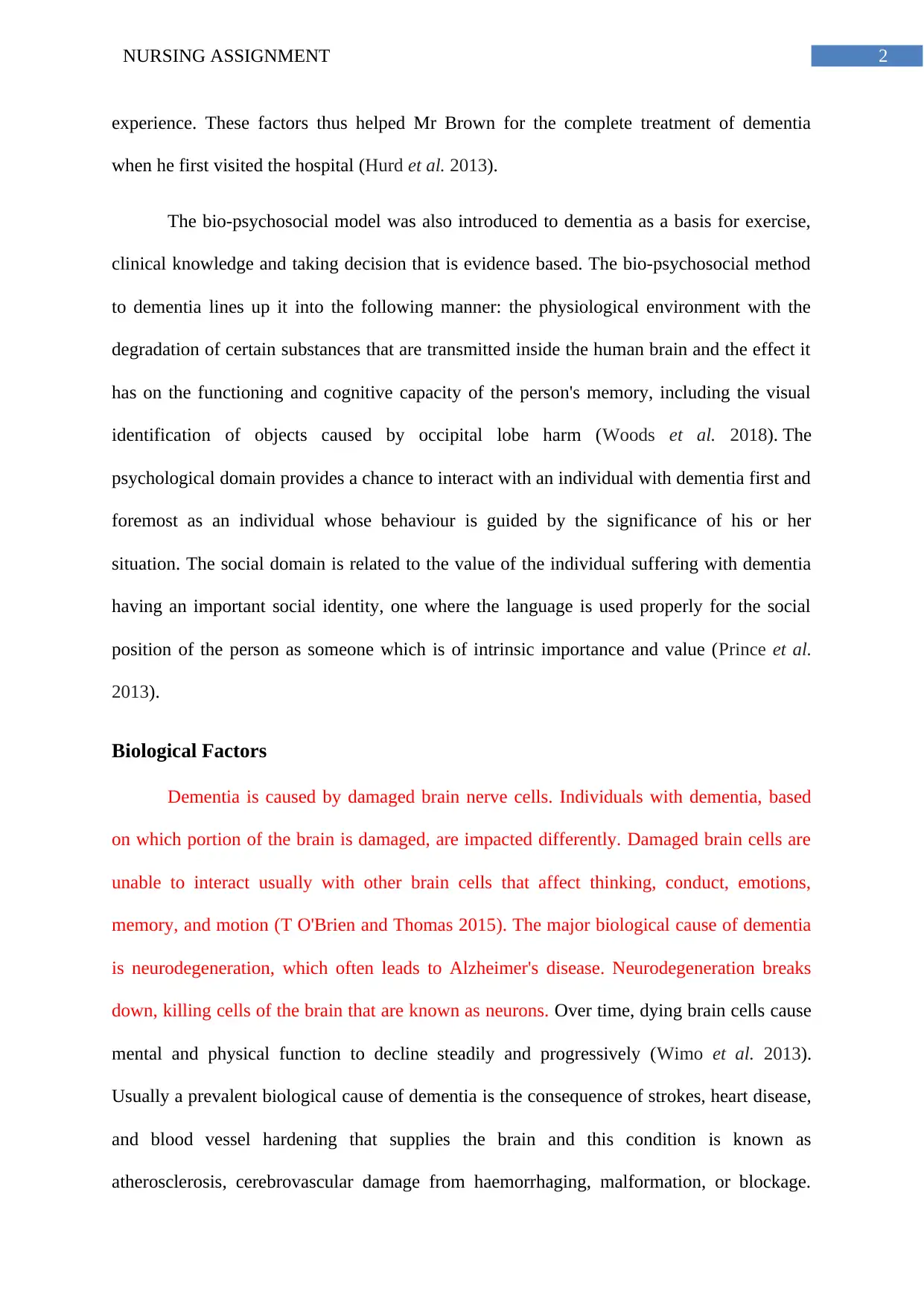
2NURSING ASSIGNMENT
experience. These factors thus helped Mr Brown for the complete treatment of dementia
when he first visited the hospital (Hurd et al. 2013).
The bio-psychosocial model was also introduced to dementia as a basis for exercise,
clinical knowledge and taking decision that is evidence based. The bio-psychosocial method
to dementia lines up it into the following manner: the physiological environment with the
degradation of certain substances that are transmitted inside the human brain and the effect it
has on the functioning and cognitive capacity of the person's memory, including the visual
identification of objects caused by occipital lobe harm (Woods et al. 2018). The
psychological domain provides a chance to interact with an individual with dementia first and
foremost as an individual whose behaviour is guided by the significance of his or her
situation. The social domain is related to the value of the individual suffering with dementia
having an important social identity, one where the language is used properly for the social
position of the person as someone which is of intrinsic importance and value (Prince et al.
2013).
Biological Factors
Dementia is caused by damaged brain nerve cells. Individuals with dementia, based
on which portion of the brain is damaged, are impacted differently. Damaged brain cells are
unable to interact usually with other brain cells that affect thinking, conduct, emotions,
memory, and motion (T O'Brien and Thomas 2015). The major biological cause of dementia
is neurodegeneration, which often leads to Alzheimer's disease. Neurodegeneration breaks
down, killing cells of the brain that are known as neurons. Over time, dying brain cells cause
mental and physical function to decline steadily and progressively (Wimo et al. 2013).
Usually a prevalent biological cause of dementia is the consequence of strokes, heart disease,
and blood vessel hardening that supplies the brain and this condition is known as
atherosclerosis, cerebrovascular damage from haemorrhaging, malformation, or blockage.
experience. These factors thus helped Mr Brown for the complete treatment of dementia
when he first visited the hospital (Hurd et al. 2013).
The bio-psychosocial model was also introduced to dementia as a basis for exercise,
clinical knowledge and taking decision that is evidence based. The bio-psychosocial method
to dementia lines up it into the following manner: the physiological environment with the
degradation of certain substances that are transmitted inside the human brain and the effect it
has on the functioning and cognitive capacity of the person's memory, including the visual
identification of objects caused by occipital lobe harm (Woods et al. 2018). The
psychological domain provides a chance to interact with an individual with dementia first and
foremost as an individual whose behaviour is guided by the significance of his or her
situation. The social domain is related to the value of the individual suffering with dementia
having an important social identity, one where the language is used properly for the social
position of the person as someone which is of intrinsic importance and value (Prince et al.
2013).
Biological Factors
Dementia is caused by damaged brain nerve cells. Individuals with dementia, based
on which portion of the brain is damaged, are impacted differently. Damaged brain cells are
unable to interact usually with other brain cells that affect thinking, conduct, emotions,
memory, and motion (T O'Brien and Thomas 2015). The major biological cause of dementia
is neurodegeneration, which often leads to Alzheimer's disease. Neurodegeneration breaks
down, killing cells of the brain that are known as neurons. Over time, dying brain cells cause
mental and physical function to decline steadily and progressively (Wimo et al. 2013).
Usually a prevalent biological cause of dementia is the consequence of strokes, heart disease,
and blood vessel hardening that supplies the brain and this condition is known as
atherosclerosis, cerebrovascular damage from haemorrhaging, malformation, or blockage.
⊘ This is a preview!⊘
Do you want full access?
Subscribe today to unlock all pages.

Trusted by 1+ million students worldwide
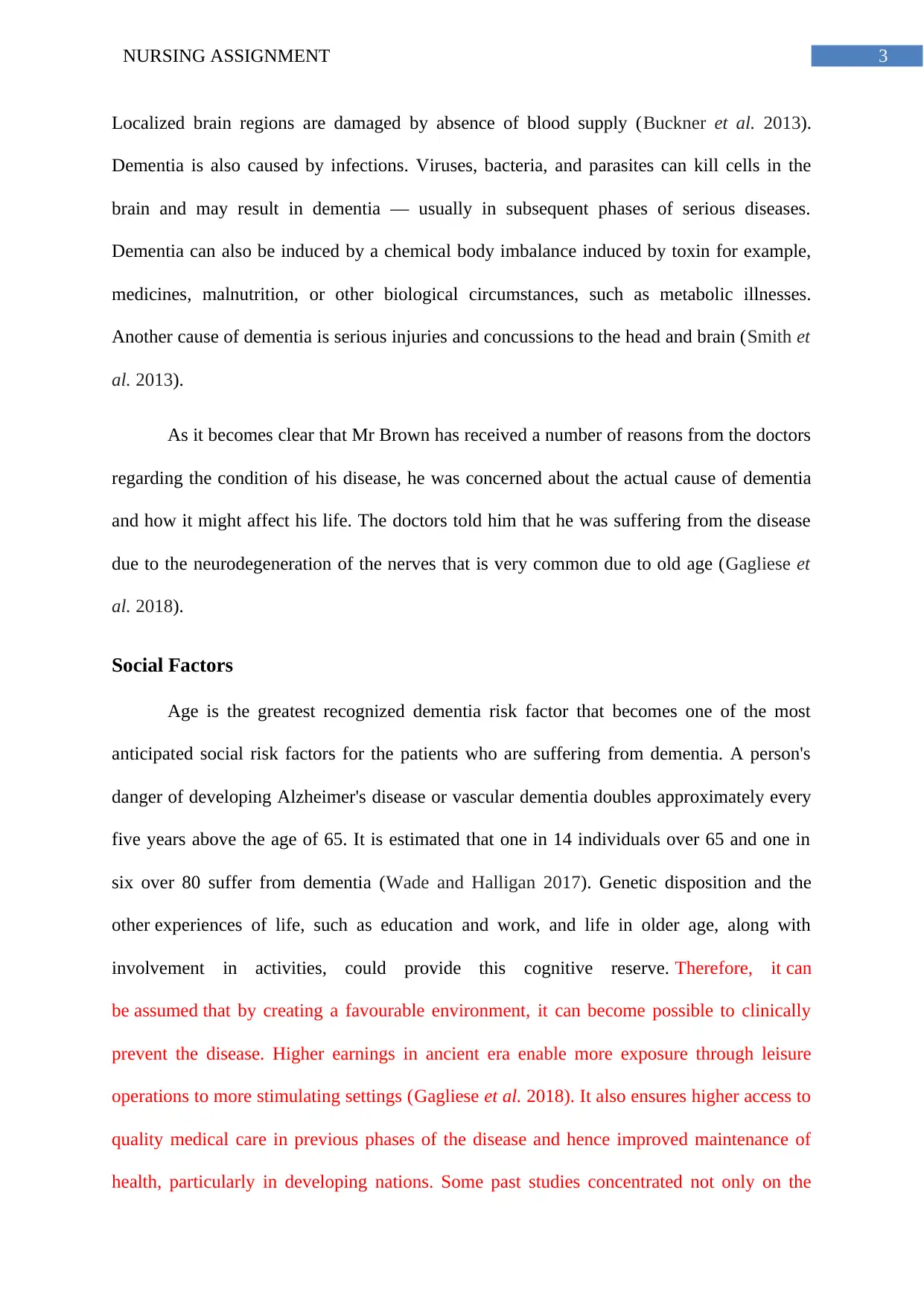
3NURSING ASSIGNMENT
Localized brain regions are damaged by absence of blood supply (Buckner et al. 2013).
Dementia is also caused by infections. Viruses, bacteria, and parasites can kill cells in the
brain and may result in dementia — usually in subsequent phases of serious diseases.
Dementia can also be induced by a chemical body imbalance induced by toxin for example,
medicines, malnutrition, or other biological circumstances, such as metabolic illnesses.
Another cause of dementia is serious injuries and concussions to the head and brain (Smith et
al. 2013).
As it becomes clear that Mr Brown has received a number of reasons from the doctors
regarding the condition of his disease, he was concerned about the actual cause of dementia
and how it might affect his life. The doctors told him that he was suffering from the disease
due to the neurodegeneration of the nerves that is very common due to old age (Gagliese et
al. 2018).
Social Factors
Age is the greatest recognized dementia risk factor that becomes one of the most
anticipated social risk factors for the patients who are suffering from dementia. A person's
danger of developing Alzheimer's disease or vascular dementia doubles approximately every
five years above the age of 65. It is estimated that one in 14 individuals over 65 and one in
six over 80 suffer from dementia (Wade and Halligan 2017). Genetic disposition and the
other experiences of life, such as education and work, and life in older age, along with
involvement in activities, could provide this cognitive reserve. Therefore, it can
be assumed that by creating a favourable environment, it can become possible to clinically
prevent the disease. Higher earnings in ancient era enable more exposure through leisure
operations to more stimulating settings (Gagliese et al. 2018). It also ensures higher access to
quality medical care in previous phases of the disease and hence improved maintenance of
health, particularly in developing nations. Some past studies concentrated not only on the
Localized brain regions are damaged by absence of blood supply (Buckner et al. 2013).
Dementia is also caused by infections. Viruses, bacteria, and parasites can kill cells in the
brain and may result in dementia — usually in subsequent phases of serious diseases.
Dementia can also be induced by a chemical body imbalance induced by toxin for example,
medicines, malnutrition, or other biological circumstances, such as metabolic illnesses.
Another cause of dementia is serious injuries and concussions to the head and brain (Smith et
al. 2013).
As it becomes clear that Mr Brown has received a number of reasons from the doctors
regarding the condition of his disease, he was concerned about the actual cause of dementia
and how it might affect his life. The doctors told him that he was suffering from the disease
due to the neurodegeneration of the nerves that is very common due to old age (Gagliese et
al. 2018).
Social Factors
Age is the greatest recognized dementia risk factor that becomes one of the most
anticipated social risk factors for the patients who are suffering from dementia. A person's
danger of developing Alzheimer's disease or vascular dementia doubles approximately every
five years above the age of 65. It is estimated that one in 14 individuals over 65 and one in
six over 80 suffer from dementia (Wade and Halligan 2017). Genetic disposition and the
other experiences of life, such as education and work, and life in older age, along with
involvement in activities, could provide this cognitive reserve. Therefore, it can
be assumed that by creating a favourable environment, it can become possible to clinically
prevent the disease. Higher earnings in ancient era enable more exposure through leisure
operations to more stimulating settings (Gagliese et al. 2018). It also ensures higher access to
quality medical care in previous phases of the disease and hence improved maintenance of
health, particularly in developing nations. Some past studies concentrated not only on the
Paraphrase This Document
Need a fresh take? Get an instant paraphrase of this document with our AI Paraphraser
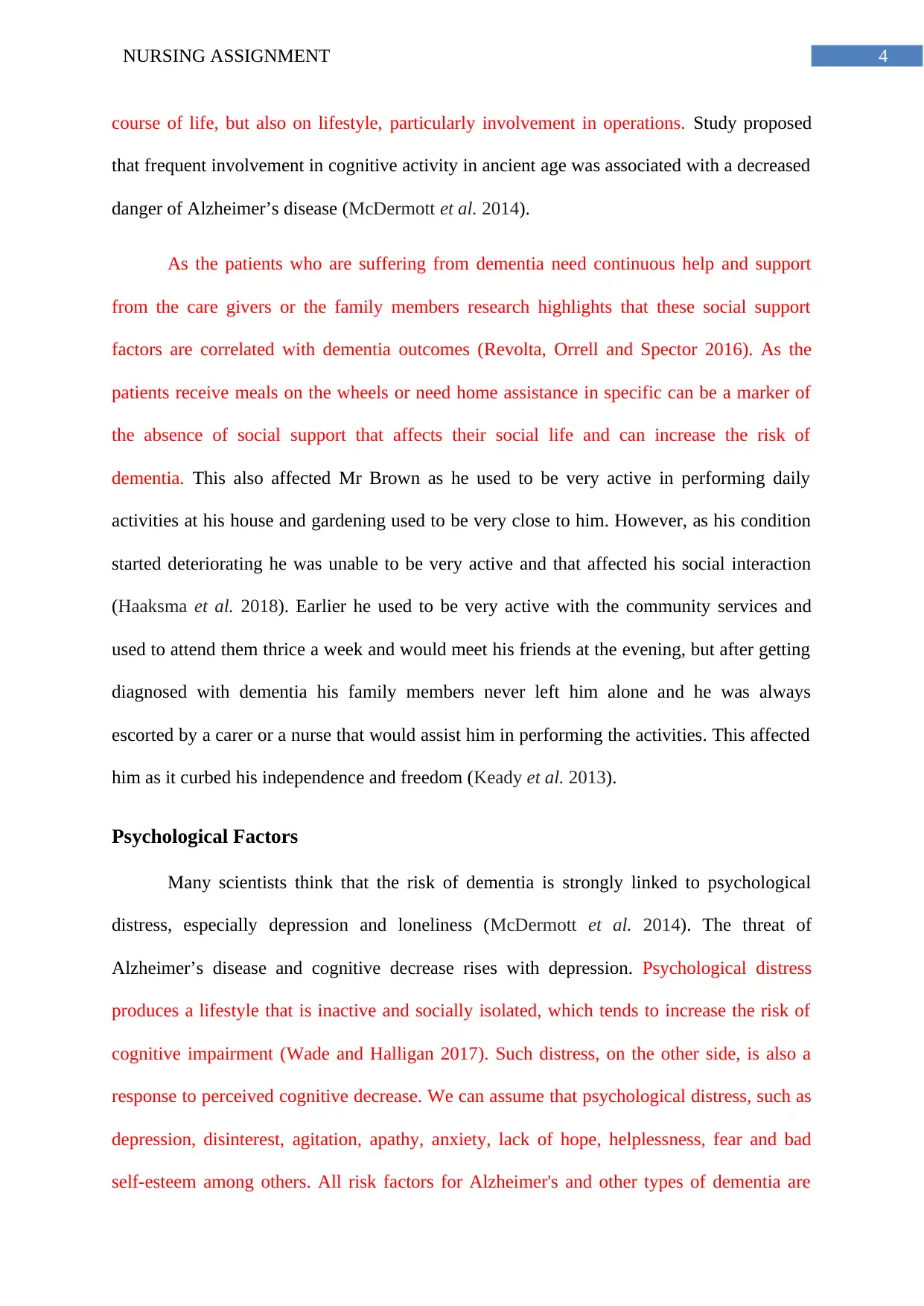
4NURSING ASSIGNMENT
course of life, but also on lifestyle, particularly involvement in operations. Study proposed
that frequent involvement in cognitive activity in ancient age was associated with a decreased
danger of Alzheimer’s disease (McDermott et al. 2014).
As the patients who are suffering from dementia need continuous help and support
from the care givers or the family members research highlights that these social support
factors are correlated with dementia outcomes (Revolta, Orrell and Spector 2016). As the
patients receive meals on the wheels or need home assistance in specific can be a marker of
the absence of social support that affects their social life and can increase the risk of
dementia. This also affected Mr Brown as he used to be very active in performing daily
activities at his house and gardening used to be very close to him. However, as his condition
started deteriorating he was unable to be very active and that affected his social interaction
(Haaksma et al. 2018). Earlier he used to be very active with the community services and
used to attend them thrice a week and would meet his friends at the evening, but after getting
diagnosed with dementia his family members never left him alone and he was always
escorted by a carer or a nurse that would assist him in performing the activities. This affected
him as it curbed his independence and freedom (Keady et al. 2013).
Psychological Factors
Many scientists think that the risk of dementia is strongly linked to psychological
distress, especially depression and loneliness (McDermott et al. 2014). The threat of
Alzheimer’s disease and cognitive decrease rises with depression. Psychological distress
produces a lifestyle that is inactive and socially isolated, which tends to increase the risk of
cognitive impairment (Wade and Halligan 2017). Such distress, on the other side, is also a
response to perceived cognitive decrease. We can assume that psychological distress, such as
depression, disinterest, agitation, apathy, anxiety, lack of hope, helplessness, fear and bad
self-esteem among others. All risk factors for Alzheimer's and other types of dementia are
course of life, but also on lifestyle, particularly involvement in operations. Study proposed
that frequent involvement in cognitive activity in ancient age was associated with a decreased
danger of Alzheimer’s disease (McDermott et al. 2014).
As the patients who are suffering from dementia need continuous help and support
from the care givers or the family members research highlights that these social support
factors are correlated with dementia outcomes (Revolta, Orrell and Spector 2016). As the
patients receive meals on the wheels or need home assistance in specific can be a marker of
the absence of social support that affects their social life and can increase the risk of
dementia. This also affected Mr Brown as he used to be very active in performing daily
activities at his house and gardening used to be very close to him. However, as his condition
started deteriorating he was unable to be very active and that affected his social interaction
(Haaksma et al. 2018). Earlier he used to be very active with the community services and
used to attend them thrice a week and would meet his friends at the evening, but after getting
diagnosed with dementia his family members never left him alone and he was always
escorted by a carer or a nurse that would assist him in performing the activities. This affected
him as it curbed his independence and freedom (Keady et al. 2013).
Psychological Factors
Many scientists think that the risk of dementia is strongly linked to psychological
distress, especially depression and loneliness (McDermott et al. 2014). The threat of
Alzheimer’s disease and cognitive decrease rises with depression. Psychological distress
produces a lifestyle that is inactive and socially isolated, which tends to increase the risk of
cognitive impairment (Wade and Halligan 2017). Such distress, on the other side, is also a
response to perceived cognitive decrease. We can assume that psychological distress, such as
depression, disinterest, agitation, apathy, anxiety, lack of hope, helplessness, fear and bad
self-esteem among others. All risk factors for Alzheimer's and other types of dementia are
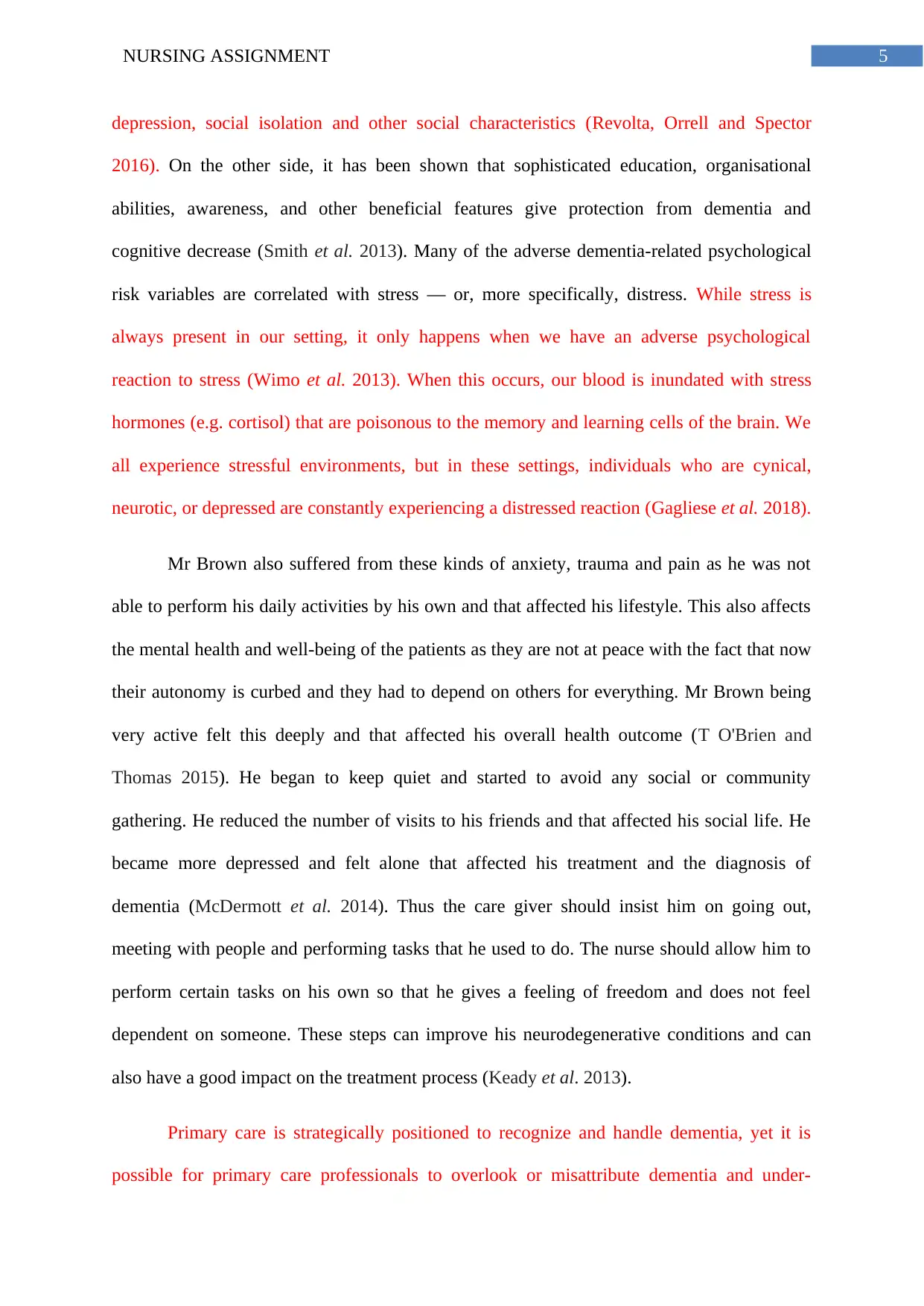
5NURSING ASSIGNMENT
depression, social isolation and other social characteristics (Revolta, Orrell and Spector
2016). On the other side, it has been shown that sophisticated education, organisational
abilities, awareness, and other beneficial features give protection from dementia and
cognitive decrease (Smith et al. 2013). Many of the adverse dementia-related psychological
risk variables are correlated with stress — or, more specifically, distress. While stress is
always present in our setting, it only happens when we have an adverse psychological
reaction to stress (Wimo et al. 2013). When this occurs, our blood is inundated with stress
hormones (e.g. cortisol) that are poisonous to the memory and learning cells of the brain. We
all experience stressful environments, but in these settings, individuals who are cynical,
neurotic, or depressed are constantly experiencing a distressed reaction (Gagliese et al. 2018).
Mr Brown also suffered from these kinds of anxiety, trauma and pain as he was not
able to perform his daily activities by his own and that affected his lifestyle. This also affects
the mental health and well-being of the patients as they are not at peace with the fact that now
their autonomy is curbed and they had to depend on others for everything. Mr Brown being
very active felt this deeply and that affected his overall health outcome (T O'Brien and
Thomas 2015). He began to keep quiet and started to avoid any social or community
gathering. He reduced the number of visits to his friends and that affected his social life. He
became more depressed and felt alone that affected his treatment and the diagnosis of
dementia (McDermott et al. 2014). Thus the care giver should insist him on going out,
meeting with people and performing tasks that he used to do. The nurse should allow him to
perform certain tasks on his own so that he gives a feeling of freedom and does not feel
dependent on someone. These steps can improve his neurodegenerative conditions and can
also have a good impact on the treatment process (Keady et al. 2013).
Primary care is strategically positioned to recognize and handle dementia, yet it is
possible for primary care professionals to overlook or misattribute dementia and under-
depression, social isolation and other social characteristics (Revolta, Orrell and Spector
2016). On the other side, it has been shown that sophisticated education, organisational
abilities, awareness, and other beneficial features give protection from dementia and
cognitive decrease (Smith et al. 2013). Many of the adverse dementia-related psychological
risk variables are correlated with stress — or, more specifically, distress. While stress is
always present in our setting, it only happens when we have an adverse psychological
reaction to stress (Wimo et al. 2013). When this occurs, our blood is inundated with stress
hormones (e.g. cortisol) that are poisonous to the memory and learning cells of the brain. We
all experience stressful environments, but in these settings, individuals who are cynical,
neurotic, or depressed are constantly experiencing a distressed reaction (Gagliese et al. 2018).
Mr Brown also suffered from these kinds of anxiety, trauma and pain as he was not
able to perform his daily activities by his own and that affected his lifestyle. This also affects
the mental health and well-being of the patients as they are not at peace with the fact that now
their autonomy is curbed and they had to depend on others for everything. Mr Brown being
very active felt this deeply and that affected his overall health outcome (T O'Brien and
Thomas 2015). He began to keep quiet and started to avoid any social or community
gathering. He reduced the number of visits to his friends and that affected his social life. He
became more depressed and felt alone that affected his treatment and the diagnosis of
dementia (McDermott et al. 2014). Thus the care giver should insist him on going out,
meeting with people and performing tasks that he used to do. The nurse should allow him to
perform certain tasks on his own so that he gives a feeling of freedom and does not feel
dependent on someone. These steps can improve his neurodegenerative conditions and can
also have a good impact on the treatment process (Keady et al. 2013).
Primary care is strategically positioned to recognize and handle dementia, yet it is
possible for primary care professionals to overlook or misattribute dementia and under-
⊘ This is a preview!⊘
Do you want full access?
Subscribe today to unlock all pages.

Trusted by 1+ million students worldwide
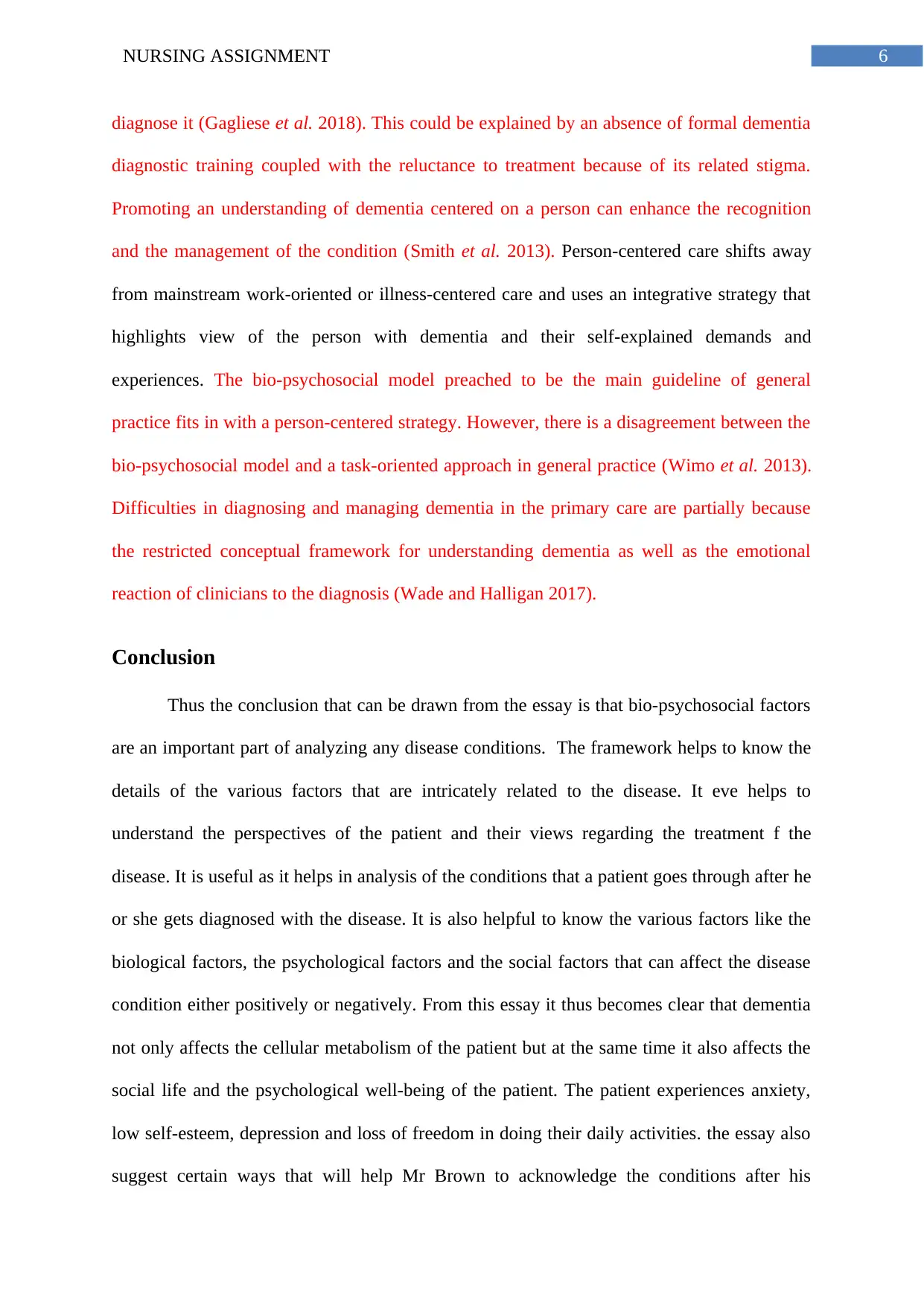
6NURSING ASSIGNMENT
diagnose it (Gagliese et al. 2018). This could be explained by an absence of formal dementia
diagnostic training coupled with the reluctance to treatment because of its related stigma.
Promoting an understanding of dementia centered on a person can enhance the recognition
and the management of the condition (Smith et al. 2013). Person-centered care shifts away
from mainstream work-oriented or illness-centered care and uses an integrative strategy that
highlights view of the person with dementia and their self-explained demands and
experiences. The bio-psychosocial model preached to be the main guideline of general
practice fits in with a person-centered strategy. However, there is a disagreement between the
bio-psychosocial model and a task-oriented approach in general practice (Wimo et al. 2013).
Difficulties in diagnosing and managing dementia in the primary care are partially because
the restricted conceptual framework for understanding dementia as well as the emotional
reaction of clinicians to the diagnosis (Wade and Halligan 2017).
Conclusion
Thus the conclusion that can be drawn from the essay is that bio-psychosocial factors
are an important part of analyzing any disease conditions. The framework helps to know the
details of the various factors that are intricately related to the disease. It eve helps to
understand the perspectives of the patient and their views regarding the treatment f the
disease. It is useful as it helps in analysis of the conditions that a patient goes through after he
or she gets diagnosed with the disease. It is also helpful to know the various factors like the
biological factors, the psychological factors and the social factors that can affect the disease
condition either positively or negatively. From this essay it thus becomes clear that dementia
not only affects the cellular metabolism of the patient but at the same time it also affects the
social life and the psychological well-being of the patient. The patient experiences anxiety,
low self-esteem, depression and loss of freedom in doing their daily activities. the essay also
suggest certain ways that will help Mr Brown to acknowledge the conditions after his
diagnose it (Gagliese et al. 2018). This could be explained by an absence of formal dementia
diagnostic training coupled with the reluctance to treatment because of its related stigma.
Promoting an understanding of dementia centered on a person can enhance the recognition
and the management of the condition (Smith et al. 2013). Person-centered care shifts away
from mainstream work-oriented or illness-centered care and uses an integrative strategy that
highlights view of the person with dementia and their self-explained demands and
experiences. The bio-psychosocial model preached to be the main guideline of general
practice fits in with a person-centered strategy. However, there is a disagreement between the
bio-psychosocial model and a task-oriented approach in general practice (Wimo et al. 2013).
Difficulties in diagnosing and managing dementia in the primary care are partially because
the restricted conceptual framework for understanding dementia as well as the emotional
reaction of clinicians to the diagnosis (Wade and Halligan 2017).
Conclusion
Thus the conclusion that can be drawn from the essay is that bio-psychosocial factors
are an important part of analyzing any disease conditions. The framework helps to know the
details of the various factors that are intricately related to the disease. It eve helps to
understand the perspectives of the patient and their views regarding the treatment f the
disease. It is useful as it helps in analysis of the conditions that a patient goes through after he
or she gets diagnosed with the disease. It is also helpful to know the various factors like the
biological factors, the psychological factors and the social factors that can affect the disease
condition either positively or negatively. From this essay it thus becomes clear that dementia
not only affects the cellular metabolism of the patient but at the same time it also affects the
social life and the psychological well-being of the patient. The patient experiences anxiety,
low self-esteem, depression and loss of freedom in doing their daily activities. the essay also
suggest certain ways that will help Mr Brown to acknowledge the conditions after his
Paraphrase This Document
Need a fresh take? Get an instant paraphrase of this document with our AI Paraphraser

7NURSING ASSIGNMENT
diagnosis with the disease and that involves actively participating in the mental and social
activities as that is the most cost-effective method to mitigate the risk of dementia. The essay
also highlights on the concept of self-care that is very necessary at times when there is
absence of medical facilities.
diagnosis with the disease and that involves actively participating in the mental and social
activities as that is the most cost-effective method to mitigate the risk of dementia. The essay
also highlights on the concept of self-care that is very necessary at times when there is
absence of medical facilities.
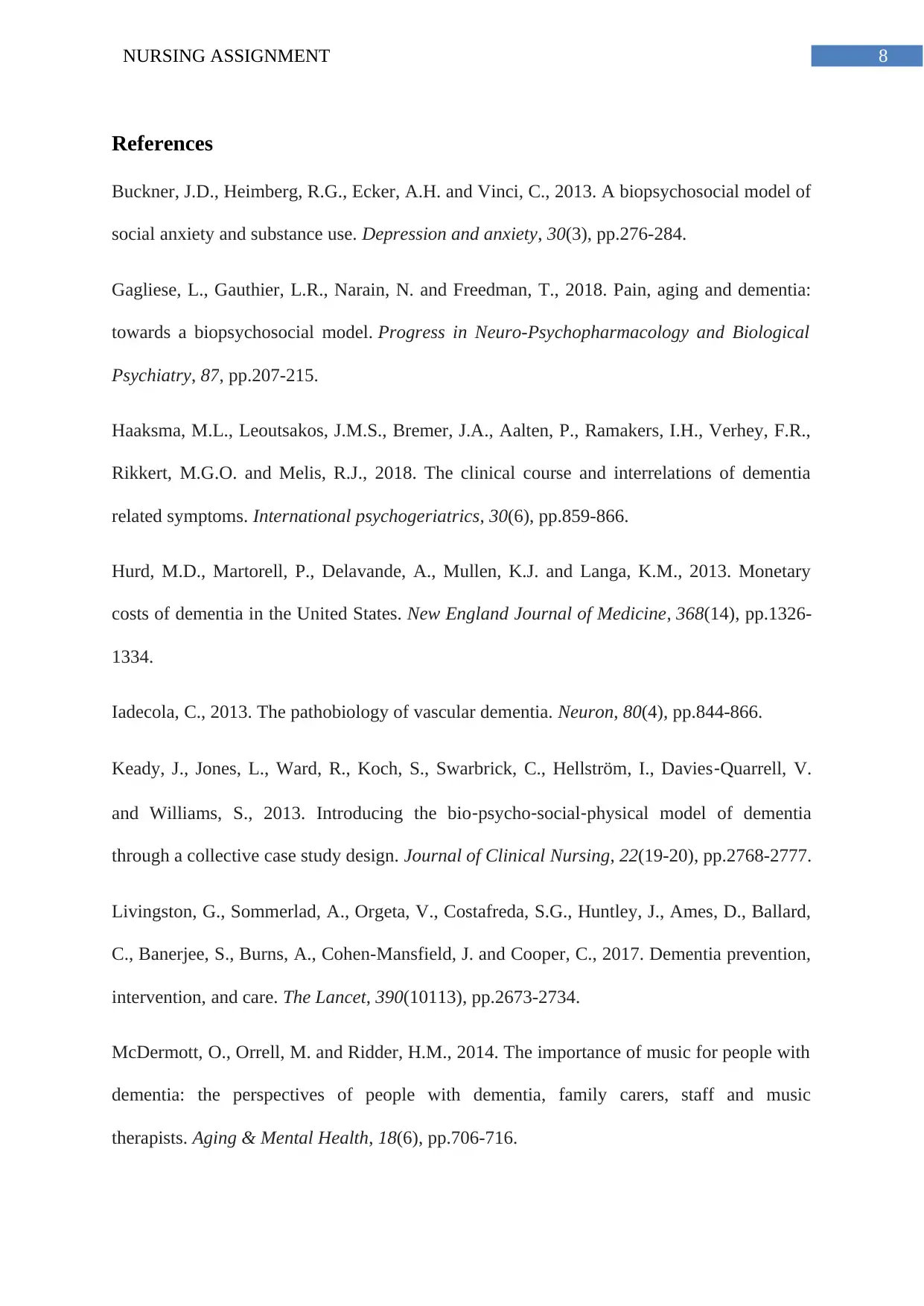
8NURSING ASSIGNMENT
References
Buckner, J.D., Heimberg, R.G., Ecker, A.H. and Vinci, C., 2013. A biopsychosocial model of
social anxiety and substance use. Depression and anxiety, 30(3), pp.276-284.
Gagliese, L., Gauthier, L.R., Narain, N. and Freedman, T., 2018. Pain, aging and dementia:
towards a biopsychosocial model. Progress in Neuro-Psychopharmacology and Biological
Psychiatry, 87, pp.207-215.
Haaksma, M.L., Leoutsakos, J.M.S., Bremer, J.A., Aalten, P., Ramakers, I.H., Verhey, F.R.,
Rikkert, M.G.O. and Melis, R.J., 2018. The clinical course and interrelations of dementia
related symptoms. International psychogeriatrics, 30(6), pp.859-866.
Hurd, M.D., Martorell, P., Delavande, A., Mullen, K.J. and Langa, K.M., 2013. Monetary
costs of dementia in the United States. New England Journal of Medicine, 368(14), pp.1326-
1334.
Iadecola, C., 2013. The pathobiology of vascular dementia. Neuron, 80(4), pp.844-866.
Keady, J., Jones, L., Ward, R., Koch, S., Swarbrick, C., Hellström, I., Davies‐Quarrell, V.
and Williams, S., 2013. Introducing the bio‐psycho‐social‐physical model of dementia
through a collective case study design. Journal of Clinical Nursing, 22(19-20), pp.2768-2777.
Livingston, G., Sommerlad, A., Orgeta, V., Costafreda, S.G., Huntley, J., Ames, D., Ballard,
C., Banerjee, S., Burns, A., Cohen-Mansfield, J. and Cooper, C., 2017. Dementia prevention,
intervention, and care. The Lancet, 390(10113), pp.2673-2734.
McDermott, O., Orrell, M. and Ridder, H.M., 2014. The importance of music for people with
dementia: the perspectives of people with dementia, family carers, staff and music
therapists. Aging & Mental Health, 18(6), pp.706-716.
References
Buckner, J.D., Heimberg, R.G., Ecker, A.H. and Vinci, C., 2013. A biopsychosocial model of
social anxiety and substance use. Depression and anxiety, 30(3), pp.276-284.
Gagliese, L., Gauthier, L.R., Narain, N. and Freedman, T., 2018. Pain, aging and dementia:
towards a biopsychosocial model. Progress in Neuro-Psychopharmacology and Biological
Psychiatry, 87, pp.207-215.
Haaksma, M.L., Leoutsakos, J.M.S., Bremer, J.A., Aalten, P., Ramakers, I.H., Verhey, F.R.,
Rikkert, M.G.O. and Melis, R.J., 2018. The clinical course and interrelations of dementia
related symptoms. International psychogeriatrics, 30(6), pp.859-866.
Hurd, M.D., Martorell, P., Delavande, A., Mullen, K.J. and Langa, K.M., 2013. Monetary
costs of dementia in the United States. New England Journal of Medicine, 368(14), pp.1326-
1334.
Iadecola, C., 2013. The pathobiology of vascular dementia. Neuron, 80(4), pp.844-866.
Keady, J., Jones, L., Ward, R., Koch, S., Swarbrick, C., Hellström, I., Davies‐Quarrell, V.
and Williams, S., 2013. Introducing the bio‐psycho‐social‐physical model of dementia
through a collective case study design. Journal of Clinical Nursing, 22(19-20), pp.2768-2777.
Livingston, G., Sommerlad, A., Orgeta, V., Costafreda, S.G., Huntley, J., Ames, D., Ballard,
C., Banerjee, S., Burns, A., Cohen-Mansfield, J. and Cooper, C., 2017. Dementia prevention,
intervention, and care. The Lancet, 390(10113), pp.2673-2734.
McDermott, O., Orrell, M. and Ridder, H.M., 2014. The importance of music for people with
dementia: the perspectives of people with dementia, family carers, staff and music
therapists. Aging & Mental Health, 18(6), pp.706-716.
⊘ This is a preview!⊘
Do you want full access?
Subscribe today to unlock all pages.

Trusted by 1+ million students worldwide
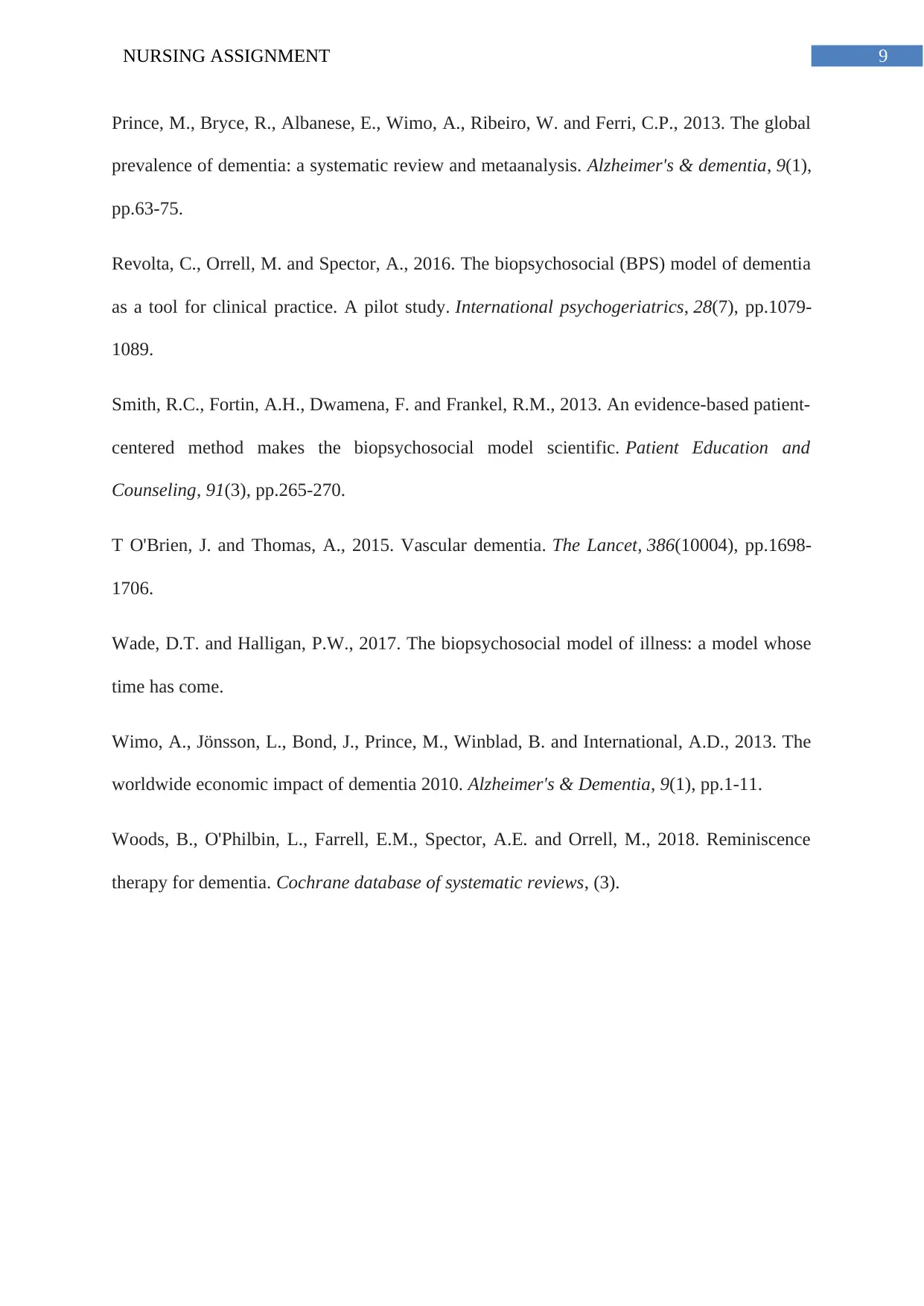
9NURSING ASSIGNMENT
Prince, M., Bryce, R., Albanese, E., Wimo, A., Ribeiro, W. and Ferri, C.P., 2013. The global
prevalence of dementia: a systematic review and metaanalysis. Alzheimer's & dementia, 9(1),
pp.63-75.
Revolta, C., Orrell, M. and Spector, A., 2016. The biopsychosocial (BPS) model of dementia
as a tool for clinical practice. A pilot study. International psychogeriatrics, 28(7), pp.1079-
1089.
Smith, R.C., Fortin, A.H., Dwamena, F. and Frankel, R.M., 2013. An evidence-based patient-
centered method makes the biopsychosocial model scientific. Patient Education and
Counseling, 91(3), pp.265-270.
T O'Brien, J. and Thomas, A., 2015. Vascular dementia. The Lancet, 386(10004), pp.1698-
1706.
Wade, D.T. and Halligan, P.W., 2017. The biopsychosocial model of illness: a model whose
time has come.
Wimo, A., Jönsson, L., Bond, J., Prince, M., Winblad, B. and International, A.D., 2013. The
worldwide economic impact of dementia 2010. Alzheimer's & Dementia, 9(1), pp.1-11.
Woods, B., O'Philbin, L., Farrell, E.M., Spector, A.E. and Orrell, M., 2018. Reminiscence
therapy for dementia. Cochrane database of systematic reviews, (3).
Prince, M., Bryce, R., Albanese, E., Wimo, A., Ribeiro, W. and Ferri, C.P., 2013. The global
prevalence of dementia: a systematic review and metaanalysis. Alzheimer's & dementia, 9(1),
pp.63-75.
Revolta, C., Orrell, M. and Spector, A., 2016. The biopsychosocial (BPS) model of dementia
as a tool for clinical practice. A pilot study. International psychogeriatrics, 28(7), pp.1079-
1089.
Smith, R.C., Fortin, A.H., Dwamena, F. and Frankel, R.M., 2013. An evidence-based patient-
centered method makes the biopsychosocial model scientific. Patient Education and
Counseling, 91(3), pp.265-270.
T O'Brien, J. and Thomas, A., 2015. Vascular dementia. The Lancet, 386(10004), pp.1698-
1706.
Wade, D.T. and Halligan, P.W., 2017. The biopsychosocial model of illness: a model whose
time has come.
Wimo, A., Jönsson, L., Bond, J., Prince, M., Winblad, B. and International, A.D., 2013. The
worldwide economic impact of dementia 2010. Alzheimer's & Dementia, 9(1), pp.1-11.
Woods, B., O'Philbin, L., Farrell, E.M., Spector, A.E. and Orrell, M., 2018. Reminiscence
therapy for dementia. Cochrane database of systematic reviews, (3).
Paraphrase This Document
Need a fresh take? Get an instant paraphrase of this document with our AI Paraphraser

10NURSING ASSIGNMENT
1 out of 11
Related Documents
Your All-in-One AI-Powered Toolkit for Academic Success.
+13062052269
info@desklib.com
Available 24*7 on WhatsApp / Email
![[object Object]](/_next/static/media/star-bottom.7253800d.svg)
Unlock your academic potential
Copyright © 2020–2025 A2Z Services. All Rights Reserved. Developed and managed by ZUCOL.





